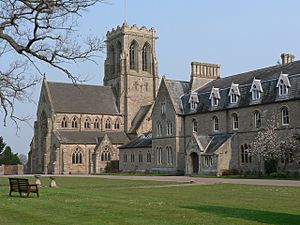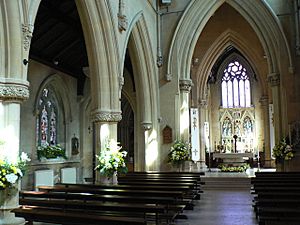Belmont Abbey, Herefordshire facts for kids
Quick facts for kids Belmont Abbey |
|
|---|---|
| Abbey Church of St Michael and All Angels, Hereford | |

View from the Abbey gardens
|
|
| Lua error in Module:Location_map at line 420: attempt to index field 'wikibase' (a nil value). | |
| OS grid reference | SO4821038149 |
| Location | Hereford, Herefordshire |
| Country | United Kingdom |
| Denomination | Roman Catholic |
| Website | BelmontAbbey.org.uk |
| History | |
| Former name(s) | Pro-Cathedral of Newport and Menevia |
| Status | Benedictine monastery |
| Founded | 1859 |
| Founder(s) | Francis Wegg-Prosser |
| Dedication | St Michael |
| Consecrated | 4 September 1860 |
| Architecture | |
| Functional status | Active |
| Heritage designation | Grade II |
| Designated | 22 October 1986 |
| Architect(s) | Edward Welby Pugin |
| Style | Gothic Revival |
| Groundbreaking | 1857 |
| Completed | 1875 |
| Construction cost | £45,000 |
| Administration | |
| Deanery | Hereford |
| Archdiocese | Cardiff |
| Province | Cardiff |
Belmont Abbey is a special place in Hereford, England. It's a Catholic Benedictine monastery, which means it's a home for monks who follow the rules of St. Benedict. It's also a parish church for the local community. The Abbey sits on a small hill, giving great views of Hereford and the Black Mountains, Wales. It was built in the 1800s.
Contents
History of Belmont Abbey
Belmont Abbey was started by Francis Wegg-Prosser. He became Catholic and decided to build a church on his land in Hereford in 1854. He wanted Benedictine monks to live there. This would make sure there was always a Catholic presence in the area.
Becoming a Priory and Abbey
The Benedictine monks arrived in 1859, and the church became a priory. A priory is a smaller monastery. It was also a special church called a "pro-cathedral" for the Diocese of Newport and Menevia. A pro-cathedral acts like a main church for a diocese until a proper cathedral is built.
Belmont was unique because its cathedral chapter was made of monks. This was common in medieval England. For example, monks were part of the main churches in Canterbury and Durham.
In 1901, Belmont was allowed to train its own new monks. Then, in 1917, it became an independent monastery. In 1920, Pope Benedict XV made Belmont a full Abbey. This was announced in a special document called a Papal bull, named Praeclara Gesta.
Changes to the Diocese
The Diocese of Newport and Menevia split in 1895. Belmont stayed as the pro-cathedral for the Newport part. In 1916, the Diocese of Newport became the Archdiocese of Cardiff. It was decided that St. David's Church in Cardiff would become the main cathedral. So, in 1920, Belmont Abbey stopped being a pro-cathedral.
On June 30, 1920, the monks at Belmont chose Aelred Kindersley as their first Abbot. An Abbot is the head of an Abbey.
The Abbey Church Building
The Abbey Church is a very important building, listed as Grade II*. This means it's a special historic place. Building started in 1857, and it was officially opened on September 4, 1860. It was designed by Edward Welby Pugin. His father, Augustus Welby Pugin, was also a famous architect.
Architecture and Design
The church is built in the Gothic Revival style. This style was popular in the 1800s and brought back old Gothic designs. The outside of the church uses local pink sandstone. It looks simple and classic, like monasteries from the 1300s.
Inside, the church is faced with warm Bath stone. Four tall, pointed arches support the central tower. This area is now where the main altar stands. Building the church cost about £45,000, which was a lot of money back then!
Stained Glass and Art
The church is famous for its beautiful sculptures and stained glass windows. Some windows show angels playing musical instruments like harps and cymbals. There's also a special screen behind the altar, called a reredos, which features angels.
One Victorian stained glass window shows the archangels Michael, Raphael, and Gabriel. Michael, who is the Abbey's patron saint, is shown with a sword and shield, defeating a dragon. The window also shows nine groups of angels praising God.
Inside the Church
Under a wooden roof is the monastic choir. This is where the monks gather five times a day. They come together for their daily prayers, known as the Divine Office, and for Mass.
There are also smaller altars dedicated to the Blessed Virgin Mary and St Joseph. Another altar remembers former students of the Abbey school who died in the Second World War. The North Transept, a part of the church, used to be a special chapel for Welsh Saints.
St Benedict's chapel was finished in 1875. It has a central reredos showing St Benedict, who founded the Benedictine order. The churchyard also has graves for soldiers from World War I and World War II.
Monastic Life at Belmont
The monks at Belmont Abbey live by the Rule of St Benedict. This rule guides their daily life, which focuses on prayer and Mass in the Abbey Church.
Education and Community Work
For many years, the monks were involved in teaching. In 1926, Belmont Abbey School was founded. It grew after the Second World War. The monks also ran two smaller schools, Alderwasley and Llanarth. These schools later closed, and the main school at Belmont closed in 1993. However, groups for former students still exist.
Today, the monks do many different kinds of work. They help care for Catholic communities in Herefordshire and South Wales. They also have a small monastery in Peru, near Lima, called the Monastery of the Incarnation. It moved to Lurín in 2018.
The monks also run Hedley Lodge, which is a place for retreats, guests, and conferences. They offer educational visits for schools from the West Midlands and Wales.
The Monks Today
Currently, there are 27 monks in the community, living in England and Peru. In 2001, a former Abbot, Mark Jabalé, became a Bishop. The current Abbot is Paul Stonham, and the current Prior is Dom Brendan Thomas.
In 2006, Belmont Abbey received a grant from the Heritage Lottery Fund. This money helped them make the Abbey Church more open to visitors. It also helped them expand their educational activities and repair parts of the church. Work on this project began in August 2008.
Leaders of Belmont Abbey
- 1859–1862: Norbert Sweeney
- 1862–1873: Bede Vaughan
- 1873–1901: Wilfrid Raynal
- 1901–1905: Ildephonsus Cummins
- 1905–1914: Clement Fowler
- 1915–1934: Aelred Kindersley
- 1934–1940: Romuald Leonard
- 1940–1948: Aidan Williams
- 1948–1953: Anselm Lightbound
- 1953–1955: Alphege Gleeson
- 1955–1966: Maurice Martin
- 1966–1970: Robert Richardson
- 1970–1986: Jerome Hodkinson
- 1986–1993: Alan Rees
- 1993–2000: Mark Jabalé
- 2000–present: Paul Stonham
Burials at Belmont Abbey
- Joseph Brown (bishop)
Parish of St Michael and All Angels
Belmont Abbey is also the local parish church for the Parish of St Michael and All Angels. This parish is part of the Catholic Deanery in Hereford, within the Archdiocese of Cardiff. Before 1859, people went to the chapel of St Peter & St Paul for Mass. That building is now used as the parish centre.
Images for kids










